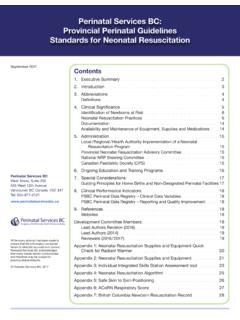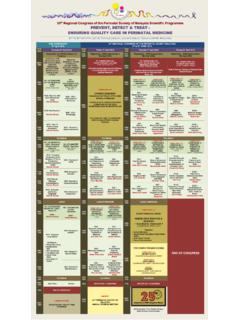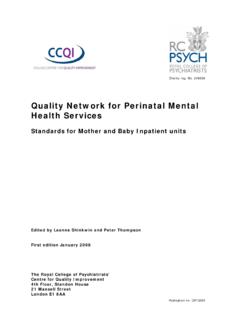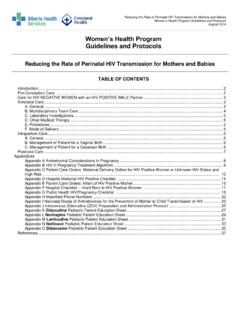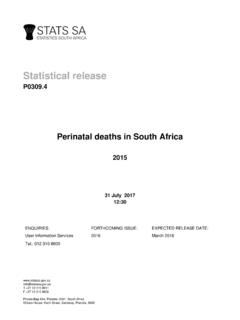Transcription of Birth and emergency Standards preparedness in …
1 Birth and emergency Standards for Maternal and preparedness in Neonatal care antenatal care INTEGRATED MANAGEMENT OF PREGNANCY AND CHILDBIRTH (IMPAC). The standard . with unexpected adverse events, such as complications or emergencies, that may occur during pregnancy, childbirth or the immediate postnatal . at each antenatal assessment and at least one month prior to the expected date of Birth . Aim To assist women and their partners and families to be adequately prepared for childbirth by making plans on how to respond if complications or unexpected adverse events occur to the woman and/or the baby at any time during pregnancy, childbirth or the early postnatal period. Requirements National and local policies support all pregnant women having access to maternal and neonatal health care , including referral care regardless of their socioeconomic situation or place of residence.
2 The health care system ensures that all health care providers who come into contact with pregnant women and their families have the capacities, including interpersonal communication and intercultural skills, to support the woman in preparing a Birth and emergency plan. The health care system ensures that all pregnant women are able to discuss and . antenatal assessment but at least one month prior to the expected date of Birth . A national or locally adapted card or home-based record exists to facilitate the development and recording of the Birth and emergency plan. National and local health education activities are undertaken to promote the need for all women to access maternal and neonatal health care , and for all pregnant women to World Health Organization make a Birth and emergency plan during pregnancy.
3 National and local activities are in place to facilitate community action to participate in, . babies with pregnancy- and Birth -related complications, especially emergencies, to a facility that has the capacity to manage such complications or emergencies. 2006. Standards Bi r th a n d e m e rg e n c y p rep ared nes s in ant enat al c are 2. Applying the standard . contact with pregnant women, their families and supporters, must: Provide information to pregnant women, their families and the broader community on the signs of labour and when to seek care if danger signs appear during pregnancy, Birth and (for both the woman and her baby) the postnatal period. Support women and their families in developing and reviewing the Birth and emergency preparedness plan, including helping them to identify a safe place for the Birth (taking account of personal and local circumstances) and deciding on the other elements of the plan such as child care and transport.
4 Support women, when needed, in discussing the plan with their partners and families.. lay health workers and community leaders the need to promote the development of Birth and emergency plans during pregnancy, and possible community or group action to support women and their babies in accessing appropriate care when needed. Disseminate information in the community on danger signs during pregnancy, Birth and the postnatal period. Regularly discuss with women and community leaders possible community action . transfer of women and newborn infants with pregnancy- or Birth -related complications. Identify women and families who have a problem accessing appropriate pregnancy, Birth or postnatal care and take action to help them ensure access or, where this is not possible, report such cases to the local authorities responsible for the provision of maternal and neonatal care .
5 Audit Input indicators The proportion of pregnant women receiving antenatal care . The proportion of pregnant women with a Birth and emergency plan.. Birth and emergency plans for pregnant women. Process and output indicators The proportion of pregnant women and of community members with knowledge of danger signs. A nationally or locally adapted card exists and is used for developing a Birth and emergency plan. Supporting educational materials for developing a Birth and emergency plan are available and are in use. Outcome indicators . The proportion of births at which a Birth companion, designated by the woman, is present. The proportion of women who recently gave Birth whose delivery took place where planned. Transport is available to referral facilities.
6 Standards Bi r th a n d e m e rg e n c y p rep ared nes s in ant enat al c are 3. Rationale . Childbirth is a normal physiological process be a useful and practical intervention with for the majority of women and a process that, several advantages (5). In particular, it can like all other life events, is looked upon with a contribute to increased use of services by mixture of anticipation and happy expectation. assisting women and their families to plan Studies in developed countries have shown for the necessary support, clothing and a positive impact on pregnancy and Birth equipment for the Birth , etc., and by making outcomes when the woman feels in control of women and their partners/families aware of the process of pregnancy and Birth ; making the potential for unexpected events (6).
7 A Birth plan has been shown to facilitate this feeling of self-control and autonomy. A Birth plan/ emergency preparedness plan . Historical evidence shows that no country elements (6 8): the desired place of Birth ;. has managed to bring its maternal mortality . ratio below 100 per 100 000 live births without the closest appropriate care facility; funds for Birth -related and emergency expenses;. appropriately skilled health professional . during labour, Birth and the period the home and children while the woman is (1). Many of the away; transport to a health facility for the complications that result in maternal deaths Birth ; transport in the case of an obstetric and many that contribute to perinatal deaths . are unpredictable, and their onset can be both blood donors in case of emergency .
8 Sudden and severe. Delay in responding to the onset of labour and such complications Birth preparedness is not easy to achieve. has been shown to be one of the major Many people in developing countries live barriers to reducing mortality and morbidity on less than US $1 a day, which is hardly surrounding childbirth (2). Information on . how to stay healthy during pregnancy and the themselves let alone put aside money for the need to obtain the services of a skilled Birth possibility of an obstetric emergency . In rural areas, the situation is even more complex: labour, and on recognizing danger signs for even if transportation (and the money to pay pregnancy-related complications and what to for it) is available in the case of an obstetric emergency , distance and lack of maintained capacities of women, their partners and their.
9 Families to remain healthy, to take appropriate the life of the woman in danger (9). steps to ensure a safe Birth and to seek timely skilled care in emergencies. Interventions to . reduce the other barriers to seeking care , such yet to show a direct correlation between Birth as transport costs, perceptions of poor quality preparedness and reducing maternal and/or perinatal mortality and morbidity, limited addressed. and small-scale studies suggest that there is . intervention (9 12) . predicting pregnancy-related complications, Two types of interventions for developing providing information, education and advice to the woman, her family and the community on seeking necessary care is seen as an that were conducted in higher-resource important part of antenatal care (5).
10 Countries focused mainly on the woman's psychological and physical comfort ( Birth Studies show that, while no clear relationship plan), while those in lower-resource countries has been found between improved knowledge tended to focus on measures to ensure a and increased health-seeking behaviour, the adoption of new practices associated with and to prepare for emergencies ( Birth . and emergency preparedness ). Birth and the Birth , transport arrangements and the emergency preparedness (also known as Birth use of Birth planning cards) at family and preparedness and complication readiness (3,4)) community levels is encouraging (9). is considered by WHO and other agencies to Standards Bi r th a n d e m e rg e n c y p rep ared nes s in ant enat al c are 4.










